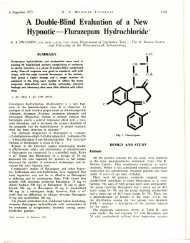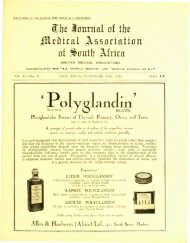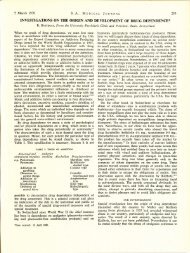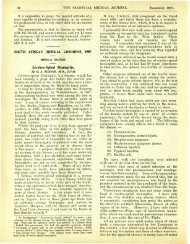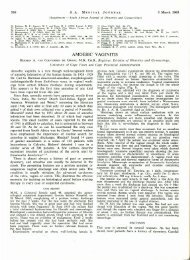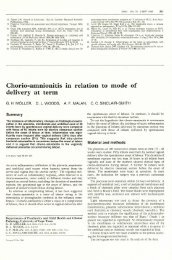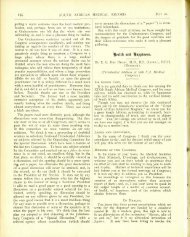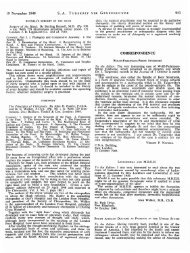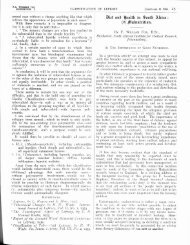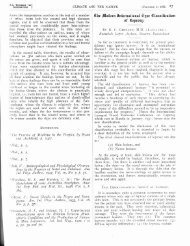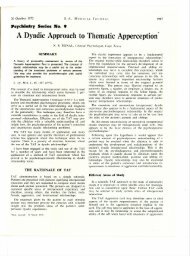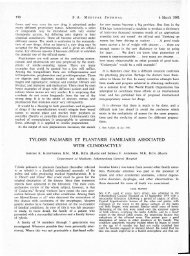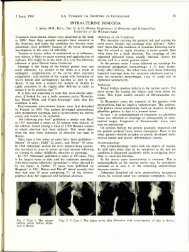3.1 BLACK PIEDRA IN A CHILD WITH PILI TORTI, BAMBOO HAIR ...
3.1 BLACK PIEDRA IN A CHILD WITH PILI TORTI, BAMBOO HAIR ...
3.1 BLACK PIEDRA IN A CHILD WITH PILI TORTI, BAMBOO HAIR ...
You also want an ePaper? Increase the reach of your titles
YUMPU automatically turns print PDFs into web optimized ePapers that Google loves.
224 S.A. MEDICAL JOURNAL 18 March 1961<br />
10<br />
Fig. 7. Bamboo hair. Typical fully developed nodule and<br />
terminal socket. The other hair shows medullary degeneration<br />
and torsion.<br />
Fig. 10. Pili torti. The irregular twisting of pili torti<br />
contrasted with the regular beading of monilethrix (on<br />
the right).<br />
that has been bent back and forth a hundred times at the<br />
same point', and when a hair fractures the broken ends<br />
look like brooms. Trichorrhexis nodosa is usually caused<br />
by chemical or physical trauma to the hair (e.g. too<br />
frequent shampooing, bleaches, violent brushing), but<br />
Touraine H mentions some families in which the tendency<br />
is inherited in dominance.<br />
etherton U entitled his article 'A unique case of<br />
trichorrhexis nodosa - "Bamboo hairs" '.In order to-avoid<br />
confusing 2 disparate conditions we believe bamboo hair<br />
should be so described tout court, and trichorrhexis nodosa<br />
reserved for the commoner state that has for long borne<br />
this name.<br />
Pili torti<br />
Pili torti (trichokinesis, trichotortosis, twisted hair,<br />
woolly hair, gedrehte Haare) was another defect found in<br />
our case. In this condition the hair is flattened and presents<br />
from 3 to 10 torsions where the shaft twists through<br />
180 0 on its axis. Danforth 15 noted that normal hair is<br />
frequently ribbon-shaped rather than cylindrical and that<br />
torsion may occur, but in pili torti there are usually many<br />
twists in a given hair, and the hairs break easily. In our<br />
case most of the scalp and eyebrow hairs examined showed<br />
multiple twists, and many hairs had both twists and<br />
bamboo nodules.<br />
Pili tqrti has often occurred in families and is then<br />
inherited as a dominant trait. Among other abnormalities<br />
which have been found in patients with pili torti are<br />
milia of the face, keratosis follicularis and classical<br />
"<br />
II<br />
Fig. 8, Bamboo hair. Fully developed nodules and<br />
terminal socket.<br />
Fig. 9. Bamboo hair. Minor changes.<br />
trichorrhexis nodosa; ichthyosis has occurred in other<br />
members of the family of a sufferer. H In a case described<br />
by Bjornstad'· the twisted hairs were fluted with longitudinal<br />
ridges and fissures. A localized growth of twisted hair<br />
followed an infection of the scalp in a case reported by<br />
Scott.'" Children with pili torti are often born with little<br />
or no scalp hair, and the abnormality may be recognized<br />
only after a year or two when a short stubble grows.<br />
In the majority of cases the hair on the occipital scalp<br />
is most affected. Twisted hairs are less elastic than normal<br />
and break easily with lengthwise splitting (trichoptilosis)<br />
leaving a broom-like end as in trichorrhexis nodosa.<br />
Breakage only rarely takes place at the first twist above<br />
the follicle. Twisting does not occur at regular intervals<br />
so that there is little likelihood of confusing pili torti with



